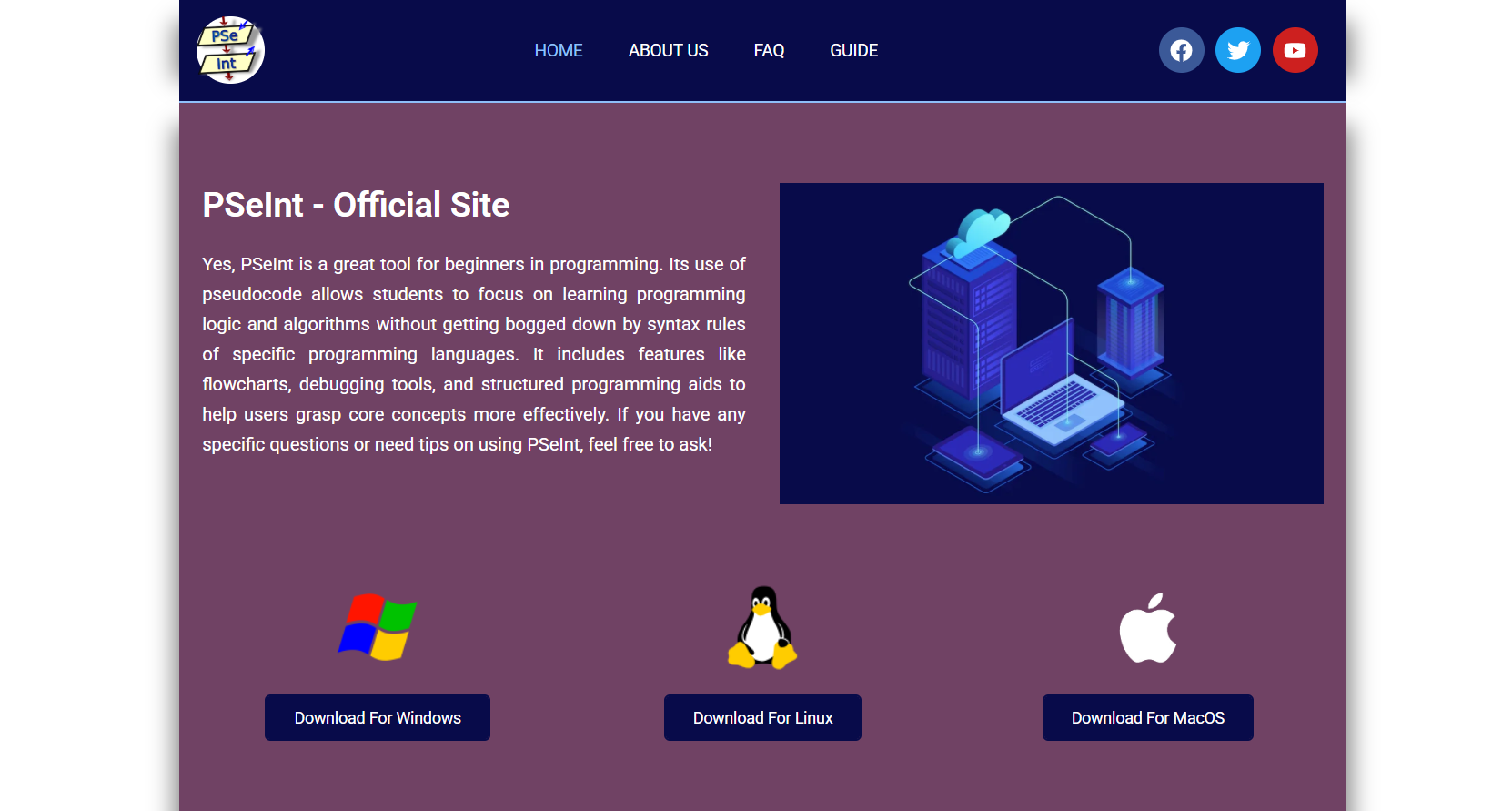PSeInt has become a go-to platform for educators and beginners exploring the foundations of programming. Developed as an educational tool, it’s designed to teach the logic behind coding through pseudocode rather than requiring knowledge of a specific programming language. When it comes to online education, especially in the field of computer science, clarity, interactivity, and accessibility are crucial. PSeInt delivers on all three fronts—making it a strong candidate for teaching programming in virtual environments.
Simplified Introduction to Programming Concepts
Learning to code can be daunting. Many students struggle with syntax errors, confusing logic, or the overwhelming variety of programming languages. PSeInt tackles this by offering a simplified environment where students can focus on algorithmic thinking without worrying about complicated syntax.
Pseudocode in PSeInt uses plain language structure, which closely mirrors natural logic and decision-making processes. For online learners, who may not have immediate instructor guidance, this intuitive approach reduces friction during self-paced learning. The platform effectively bridges the gap between logic-building and coding, helping learners create a strong foundation before transitioning into full programming languages like Python, Java, or C++.
Visual Algorithm Design for Online Learners
One of PSeInt’s standout features is its visual representation of algorithms. This is especially important in remote education settings where instructors rely heavily on visuals to communicate abstract concepts.
In PSeInt, users can create flowcharts that visually represent the logic of a program. These diagrams are automatically generated from pseudocode, allowing learners to see how written logic transforms into a logical process. For online courses, this visual feedback offers immediate clarity and reinforces conceptual understanding.
Instead of just reading about loops and conditionals, students can interact with visual algorithms—which helps deepen learning, particularly for visual learners.
Built-in Error Detection Enhances Self-Learning
Error messages in professional programming environments can be cryptic and intimidating for beginners. PSeInt provides clear, beginner-friendly error detection, pointing out not just where the issue lies but why it’s happening.
This guided correction process mimics a teacher’s feedback and is particularly useful in online learning where real-time assistance isn’t always available. By offering contextual help and suggested fixes, PSeInt enables students to troubleshoot independently, building confidence and encouraging experimentation.
For instructors managing online classes, this also reduces the number of minor questions they need to address—freeing them up to focus on more advanced concepts or personalized instruction.
Interactive Execution and Step-by-Step Simulation
PSeInt doesn’t just let students write pseudocode—it also lets them simulate code execution step-by-step. This feature is particularly powerful in distance education because it creates an interactive learning loop.
When students write an algorithm, they can run it in execution mode, watching the program simulate each line’s effect on the variables and logic. This line-by-line simulation demystifies the concept of program flow, which can otherwise be quite abstract.
For virtual classrooms, this feature turns passive lessons into interactive coding labs, even when students are learning asynchronously. Simulation builds strong mental models of how code works—something that’s difficult to achieve through video lectures alone.
Low Barrier to Entry for Students Worldwide
Accessibility is one of the biggest hurdles in global online education. PSeInt is a lightweight, free tool that runs on Windows, Linux, and macOS, making it broadly accessible to learners regardless of location or device capability.
Since the platform doesn’t require internet connectivity after installation, it’s also useful for students in regions with limited internet access. This offline functionality extends the reach of online programming courses, enabling instructors to offer a complete coding experience without depending entirely on web-based IDEs.
The open-source nature of PSeInt also means educational institutions can adopt it without licensing constraints, reducing administrative friction and making it ideal for scalable, cost-effective online education.
Aligns with Educational Standards and Teaching Goals
Many online computer science courses are designed to align with standardized curricula. PSeInt is especially well-suited for this because it focuses on universal programming concepts: loops, conditionals, variables, input/output, and logic flow.
By teaching pseudocode first, instructors ensure students develop a language-agnostic mindset—a critical asset for future programmers who may go on to learn multiple languages. The structure of PSeInt’s pseudocode closely mirrors what is commonly found in textbooks and standardized exams, making it an ideal companion to formal instruction.
Instructors can also customize exercises, share templates, and assign challenges that students can complete and submit electronically. The platform’s compatibility with file-sharing tools allows seamless integration into learning management systems (LMS) like Moodle, Canvas, or Google Classroom.
Enhances Collaboration and Remote Instruction
Instructors running group-based online classes often look for tools that enable collaboration. While PSeInt itself is a standalone application, its simplicity allows students to easily share their code via text or screenshots.
Because the pseudocode format is clean and readable, group discussions and peer reviews become easier even in online forums or video calls. Students can discuss logic and structure without getting lost in syntax debates.
For instructors, grading and feedback also become more efficient. They can quickly assess whether a student understands the underlying logic of a problem simply by reviewing the pseudocode, thereby reducing grading time and increasing the value of feedback.
Suitable for a Range of Educational Levels
PSeInt can be adapted for use in middle school, high school, college, and even adult learning programs. Its flexibility allows educators to scale the complexity of assignments based on the learner’s proficiency level.
For younger students or absolute beginners, it’s a gentle introduction to thinking algorithmically. For more advanced learners, PSeInt can be used to prototype complex logic before implementing in another language. This versatility makes it an enduring tool in long-term online learning paths.
Some educators even pair PSeInt with other teaching platforms—using it as a pseudocode planning tool before moving on to real-world coding environments. This hybrid method works particularly well in bootcamp-style online programs where the emphasis is on fast, effective learning.
Language Support and Regional Relevance
One of PSeInt’s major advantages in online education is support for Spanish-speaking learners, making it highly relevant in Latin America and other regions where Spanish is the primary language.
The interface, documentation, and tutorials are available in Spanish and partially in English, allowing for bilingual instruction. This helps break down language barriers that often complicate programming education in non-English-speaking regions.
As online education continues to expand globally, tools like PSeInt that cater to regional linguistic needs while maintaining technical rigor will play a crucial role in democratizing programming education.
Limitations to Consider in Online Settings
Despite its many benefits, PSeInt is not without limitations. It is not a substitute for actual programming environments, and it lacks integration with more advanced tools like version control systems or cloud-based IDEs.
Instructors must be clear that while PSeInt builds essential logic and structure skills, it should eventually be complemented with real programming practice. Additionally, because it is a standalone application, students need to install it, which may pose issues in locked-down institutional environments or tablets where installations aren’t allowed.
However, these drawbacks are minor when considering the value it adds during the early stages of learning.
Strong Community and Support Resources
PSeInt is supported by a passionate community of educators and developers. A wide array of tutorials, documentation, and video walkthroughs is available online, making it easy for instructors to onboard students remotely.
Many schools and instructors have developed their own PSeInt modules, which they share in open educational repositories. This growing ecosystem ensures that instructors don’t have to start from scratch when building their online curriculum around PSeInt.
Support forums and community groups also enable educators to ask questions, share ideas, and adapt best practices for online teaching.
Conclusion
PSeInt is a powerful ally for teaching programming online. Its intuitive design, visual tools, and focus on algorithmic thinking make it ideal for beginners. Whether used in high school computer science classes or as part of a college-level intro course, PSeInt simplifies the learning process while fostering deep understanding of coding logic.
For educators designing online programming curricula, PSeInt offers interactive, accessible, and pedagogically sound tools to teach the core concepts of programming—without the need for complex installations or steep learning curves.










